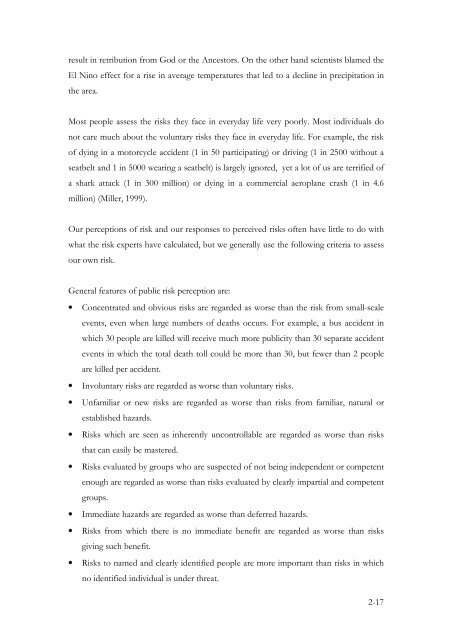A spatial multi-risk hazard assessment and vulnerability study of ...
A spatial multi-risk hazard assessment and vulnerability study of ...
A spatial multi-risk hazard assessment and vulnerability study of ...
You also want an ePaper? Increase the reach of your titles
YUMPU automatically turns print PDFs into web optimized ePapers that Google loves.
esult in retribution from God or the Ancestors. On the other h<strong>and</strong> scientists blamed the<br />
El Nino effect for a rise in average temperatures that led to a decline in precipitation in<br />
the area.<br />
Most people assess the <strong>risk</strong>s they face in everyday life very poorly. Most individuals do<br />
not care much about the voluntary <strong>risk</strong>s they face in everyday life. For example, the <strong>risk</strong><br />
<strong>of</strong> dying in a motorcycle accident (1 in 50 participating) or driving (1 in 2500 without a<br />
seatbelt <strong>and</strong> 1 in 5000 wearing a seatbelt) is largely ignored, yet a lot <strong>of</strong> us are terrified <strong>of</strong><br />
a shark attack (1 in 300 million) or dying in a commercial aeroplane crash (1 in 4.6<br />
million) (Miller, 1999).<br />
Our perceptions <strong>of</strong> <strong>risk</strong> <strong>and</strong> our responses to perceived <strong>risk</strong>s <strong>of</strong>ten have little to do with<br />
what the <strong>risk</strong> experts have calculated, but we generally use the following criteria to assess<br />
our own <strong>risk</strong>.<br />
General features <strong>of</strong> public <strong>risk</strong> perception are:<br />
• Concentrated <strong>and</strong> obvious <strong>risk</strong>s are regarded as worse than the <strong>risk</strong> from small-scale<br />
events, even when large numbers <strong>of</strong> deaths occurs. For example, a bus accident in<br />
which 30 people are killed will receive much more publicity than 30 separate accident<br />
events in which the total death toll could be more than 30, but fewer than 2 people<br />
are killed per accident.<br />
• Involuntary <strong>risk</strong>s are regarded as worse than voluntary <strong>risk</strong>s.<br />
• Unfamiliar or new <strong>risk</strong>s are regarded as worse than <strong>risk</strong>s from familiar, natural or<br />
established <strong>hazard</strong>s.<br />
• Risks which are seen as inherently uncontrollable are regarded as worse than <strong>risk</strong>s<br />
that can easily be mastered.<br />
• Risks evaluated by groups who are suspected <strong>of</strong> not being independent or competent<br />
enough are regarded as worse than <strong>risk</strong>s evaluated by clearly impartial <strong>and</strong> competent<br />
groups.<br />
• Immediate <strong>hazard</strong>s are regarded as worse than deferred <strong>hazard</strong>s.<br />
• Risks from which there is no immediate benefit are regarded as worse than <strong>risk</strong>s<br />
giving such benefit.<br />
• Risks to named <strong>and</strong> clearly identified people are more important than <strong>risk</strong>s in which<br />
no identified individual is under threat.<br />
2-17
















